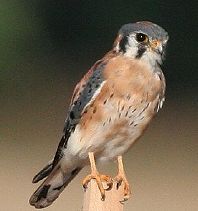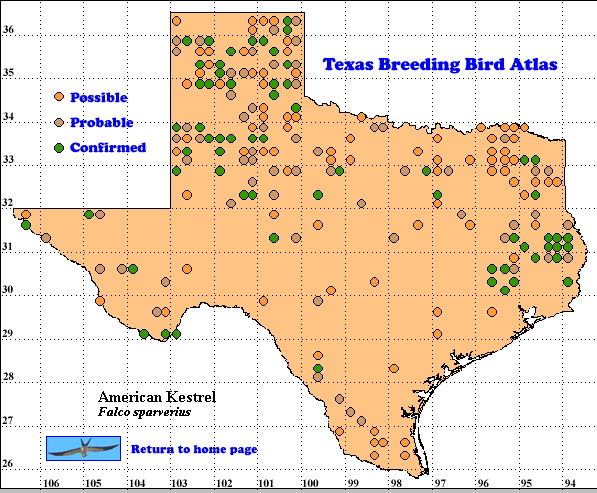The American Kestrel, formerly called Sparrow Hawk, is our smallest and most numerous falcon. Its breeding range extends from the tree line in North America south through Central and South America to Tierra del Fuego. It normally inhabits open country near scattered trees or woodlands, generally avoiding dense forests. Increasingly it is found in urban and suburban environments. The kestrel is a familiar sight along Texas highways. It often perches on utility poles and wires, fence lines and trees, tail-pumping, or hovering over open fields.Because the breeding and wintering ranges in Texas completely overlap, interpreting the status of spring kestrels was complicated for atlasers. Observers in many portions of the state had to be mindful that all late April and early May birds were not necessarily resident but possibly were migrants. This awareness was apparent from the few quadrangles south of the 30th parallel, other than those in the Big Bend, assigned a category higher than possible. The last migrants leave north, east, central, and west Texas in mid- to late April (fide W. Pulich, D. Wolf, E. Kutac and F. Williams). The first week of April is the peak of migration in the northwest (KDS).
Two races of the American Kestrel are resident in Texas, F s. sparverius in the western two-thirds and F s. paulus in the eastern third, with probable intergrades in the Trinity River drainage (Lockwood and Freeman 2004). A very light male observed in latilong 27098, quad D8 (Duval County [Co.]), was possibly of the race peninsularis found in the Chihuahuan Desert of Mexico. Albinism, however, is not rare in the American Kestrel, and the species shows a tendency to dichromatism as well (Palmer, 1988, Smallwood and Bird 2002).
DISTRIBUTION: The 267 quadrangles occupied by the American Kestrel were distributed among the ten ecological areas of Texas (McMahon, et al., 1984) as follows: 1) Pineywoods, 53 (20%); 2) Gulf Prairies and Marshes, 4 (2%); 3) Post Oak Savannah, 16 (6%); 4) Blackland Prairies, 12 (4%); 5) Cross Timbers and Prairies, 11 (4%); 6) South Texas Plains, 16 (6%); 7) Edwards Plateau, 8 (3%); 8) Rolling Plains, 87 (33%); 9) High Plains, 43 (16%); 10) Trans-Pecos, Mountains and Basins, 17 (6%).
SEASONAL OCCURRENCE: Confirmation of nesting was made in 26% of the occupied quadrangles, almost half involving active nests with eggs or young. The number probably would have been higher if atlasers had always stipulated whether adults observed feeding young involved those being fed in the nest or as fledglings. Of the remaining quads, 30% were classified as probable and 44% as possible.
Oberholser (1974) gives the breeding season of the kestrel as extending from early March to early August (eggs found from March 15 to July 15). TBBA results were in close conformity. A female either incubating eggs or brooding young was found in latilong 29102, quad B8, on the early date of March 6 , and flying young soliciting adults were observed May 19 in latilong 29103, quad B6. With an incubation period of 29-31 days and fledgling period of 30-31 days (Palmer, 1988), the eggs of this latter pair were laid no later than March 13. Both quads are in the Big Bend National Park where the kestrel is a common breeding bird along the canyons of the Rio Grande River (B. McKinney, pers. comm.).
Almost all fledging of young occurred in late May to late June. Later observations were an adult on the nest July 16 or after (latilong 32097, quad G1), and a pair engaged in courtship and copulating June 22 (latilong 33098, quad H4). Although the kestrel is believed to be single-brooded in Texas, such late activities suggest possible second broods. Nest boxes erected in the Panhandle (latilong 35101, quad C7) produced two sets of young, the first nesting initiated in April. Without being banded or color-marked, however, it was not known whether the two broods were reared by the same pair or if a young individual in either nest survived to care for itself. Once thought one-brooded in Oklahoma, there is strong evidence of two broods in that state also (Black, 1978; Sutton, 1978). Copulating pairs have been observed as early as February 17 in the Panhandle, but it is doubtful such early activity generates any fertilization (Palmer, 1988).
BREEDING HABITAT As a cavity nester, sites used were varied. Over half were built in man-made structures including a press box at a football stadium, an abandoned cotton ricker, the rocking head of an inoperative pump jack, a busy freight dock, a water tower, a church, and a porch column. Old woodpecker holes in utility poles were commonly used. Of natural sites, tree snags, woodpecker holes in trees and cavities in cliff predominated.STATUS: The TBBA summer distribution of the American Kestrel is closely comparable with that shown in Oberholser, (1974). However, the belief that the species is “practically wiped out as a breeder” in the state was not upheld. Also, the statement that nesting in the northern Panhandle is “uncommon and local” proved in error, for that region’s 26 counties were found to be the most densely populated of any and provided the highest percentage of confirmed nestings. Oberholser (1974) shows nesting in seven north central counties (Baylor, Cooke, Dallas, Fannin, Tarrant, Wichita, and Wilbarger), Pulich (1988) added two more (Grayson and Stephens), and the TBBA another two (Ellis and Hunt). The confirmed nestings in East Texas counties matched Oberholser (1974), but in other regions they were reduced, particularly in Central Texas.
While the long-term (1966-2005) trend data from the Breeding Bird Survey (Sauer et al. 2005) is a small annual decrease in the population of the American Kestrel in Texas between -3.3 and +1.4%. The short term (1980-2005) trend of -4.4% is alarming. The cause of this decline is undetermined. The species is still considered an uncommon to common breeder in the High Plains and Trans-Pecos regions and rare to uncommon in the Pineywoods. In winter and migration American Kestrels are common to abundant statewide (Lockwood and Freeman 2004).
Text by Kenneth D. Seyffert (posted with updates 2006)
Literature cited.
Black, E. A. 1978. American Kestrel possibly two-brooded in central Oklahoma. Bull. Oklahoma Ornithol. Soc. XlI: 29-30.
Lockwood, M. W. and B. Freeman. 2004. The TOS handbook of Texas birds. Texas A&M University Press, College Station.
McMahon, C. A., R. G. Frye, and K. L. Brown. 1984. The vegetation types of Texas. Pittman- Robertson Project W-107-R. Texas Parks & Wildlife Dept., Austin.
Oberholser, H. C. 1974. The bird life of Texas. University of Texas Press,. Austin.
Palmer, R. S. 1988. Handbook of North American birds, Vol. 5 (diurnal raptors). Yale University Press, New Haven, CT..
Pulich, W. M. 1988. The birds of north central Texas. Texas A&M University Press, College Station.
Sauer, J. R., J. E. Hines, and J. Fallon. 2005. The North American Breeding Bird Survey, results and analysis 1966-2005. Version 6.2 2006. USGS Patuxent Wildlife Research Center, Laurel MD < http://www.mbr-pwrc.usgs.gov/bbs>
Smallwood, J. A. and D. M. Bird 2002. American Kestrel (Falco sparverius). In The Birds of North America, No. 602 (A. Poole and F. Gill, eds.). The Birds of North America, Inc., Philadelphia, PA.
Sutton, G. M. 1978. Is the American Kestrel two-brooded in Oklahoma? Bull. Oklahoma Ornithol. Soc. Xll:30-31.

